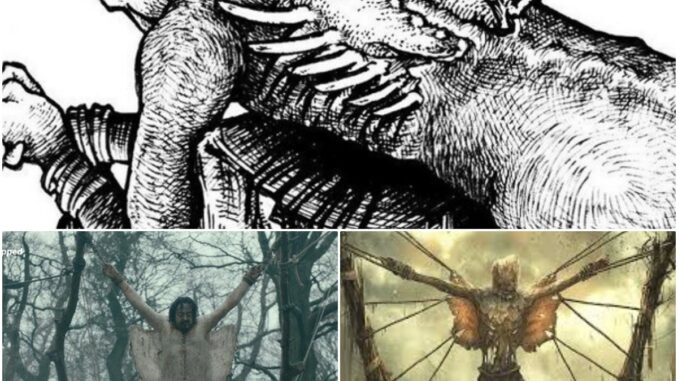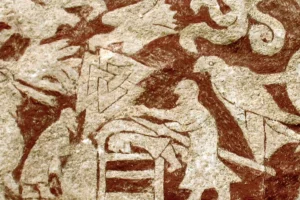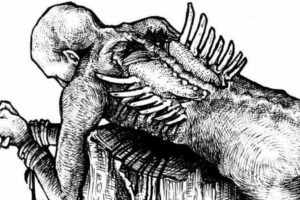
The blood eagle is one of the most gruesome and evocative rituals attributed to the ancient Norse warriors, a practice that blends visceral brutality with the poetic imagery characteristic of Viking culture. Described in Norse literature, this method of execution is said to have been reserved for the most heinous of crimes, particularly the murder of a nobleman’s father. However, its historical authenticity remains a topic of fervent debate among scholars, with some arguing it is a product of mistranslation or poetic exaggeration rather than a documented practice. This essay explores the blood eagle’s description, its cultural significance, and the ongoing controversy surrounding its existence.

The Ritual of the Blood Eagle
According to accounts in Norse sagas, the blood eagle was a meticulously cruel form of execution. The process began with the victim, typically a nobleman, being restrained face-down. The executioner would then hack open the victim’s back, slicing through the skin and muscle to expose the spinal column. The ribs were forcibly detached from the spine and bent backward, splaying them outward in a grotesque mimicry of an eagle’s wings. This act alone would have caused unimaginable pain and massive blood loss. As a final, horrifying touch, the lungs were allegedly pulled from the body cavity and draped over the broken ribs, then sprinkled with salt to intensify the agony. Death, when it came, was likely due to suffocation or blood loss, though the initial wounds would almost certainly have rendered the victim unconscious long before the ritual’s completion.
The imagery of the blood eagle is striking, evoking the eagle—a potent symbol in Norse mythology associated with blood, death, and power. The act’s poetic nature aligns with the Vikings’ penchant for blending violence with artistry, as seen in their sagas, skaldic poetry, and intricate carvings. Yet, the vividness of these descriptions raises questions about whether they reflect historical reality or serve as literary embellishments meant to amplify the fearsome reputation of Viking warriors.
Historical Evidence and Scholarly Debate
The primary sources for the blood eagle are found in Norse sagas and skaldic poetry, such as the Orkneyinga Saga and the Saga of the Volsungs. These texts describe the ritual in chilling detail, often linking it to acts of vengeance against noblemen who committed patricide. However, these accounts were written centuries after the events they purport to describe, often by Christian scribes who may have had reason to exaggerate the barbarity of their pagan ancestors. This temporal and cultural distance casts doubt on the reliability of these sources.
Some scholars argue that the blood eagle is a misunderstanding of Norse poetic imagery. The eagle, a common motif in Viking literature, was frequently associated with bloodshed and death, as it was believed to feast on the bodies of the slain. Phrases describing warriors as “eagle-feeders” or references to “blood-stained wings” may have been misinterpreted by later translators as literal descriptions of a ritual execution. Roberta Frank, a prominent scholar of Norse literature, suggests that the blood eagle may be a “literary conceit,” born from the misreading of kennings—complex metaphorical expressions common in skaldic poetry. For example, a phrase like “carving the eagle” could refer to leaving a corpse for scavengers rather than performing a specific ritual.

Conversely, other historians, such as Anders Winroth, argue that the blood eagle’s consistency across multiple sagas suggests it may have been a real, albeit rare, practice. The specificity of the descriptions—detailing the breaking of ribs and the extraction of lungs—lends a degree of credibility to the accounts, even if they were exaggerated for dramatic effect. Additionally, the ritual’s association with high-status victims and acts of vengeance aligns with Viking cultural values, where honor and retribution were paramount.
The Human Cost and Physiological Reality
If the blood eagle was indeed performed, its physical toll on the victim would have been catastrophic. The initial act of cutting open the back and severing the ribs would cause severe trauma, leading to massive blood loss and shock. Medical experts suggest that the victim would likely lose consciousness within minutes due to the intensity of the pain and blood loss. The extraction of the lungs, while horrific, would have been largely symbolic, as the victim would almost certainly have been dead or comatose by this stage. The addition of salt to the wounds, while agonizing, would have served more as a theatrical flourish than a necessary component of the execution.

his physiological reality offers a small mercy to any potential victims: the sheer brutality of the initial wounds would have spared them the full extent of the ritual’s horrors. However, the blood eagle’s purpose likely extended beyond mere punishment. Its theatrical nature suggests it was designed to send a message, intimidating enemies and reinforcing the power of the executioners.
Cultural Significance and Legacy
Whether fact or fiction, the blood eagle occupies a unique place in Viking lore, embodying the Norse fascination with blending beauty and brutality. The ritual’s imagery resonates with the Viking worldview, where death was not an end but a transformation, often depicted in grandiose and symbolic terms. The eagle, soaring above battlefields and feasting on the fallen, was a fitting metaphor for a culture that revered both warriors and poets.
The blood eagle also reflects the Vikings’ complex relationship with vengeance. In a society where family honor was sacrosanct, the murder of a father demanded a response that was both personal and public. The blood eagle, if it existed, would have served as a dramatic act of retribution, ensuring that the crime was neither forgotten nor forgiven.

Today, the blood eagle captures the modern imagination through its sheer visceral horror, appearing in popular media like the TV series . These portrayals often lean into the ritual’s gruesome details, amplifying its mystique while perpetuating the debate over its authenticity.
Conclusion
The blood eagle remains one of the most enigmatic and debated aspects of Viking history. Whether it was a real practice or a product of poetic exaggeration, its enduring fascination lies in its ability to encapsulate the Viking ethos: a blend of ferocity, artistry, and unrelenting honor. While the scholarly debate over its existence continues, the blood eagle’s vivid imagery ensures its place in the annals of Norse mythology, a haunting reminder of a time when violence and poetry walked hand in hand.